
The Cantharellaceae are a family of fungi in the order Cantharellales. The family contains the chanterelles and related species, a group of fungi that superficially resemble agarics but have smooth, wrinkled, or gill-like hymenophores. Species in the family are ectomycorrhizal, forming a mutually beneficial relationship with the roots of trees and other plants. Many of the Cantharellaceae, including the chanterelle, the Pacific golden chanterelle, the horn of plenty, and the trumpet chanterelle, are not only edible, but are collected and marketed internationally on a commercial scale.
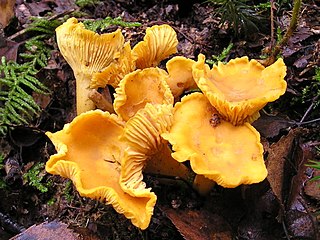
The Cantharellales are an order of fungi in the class Agaricomycetes. The order includes not only the chanterelles (Cantharellaceae), but also some of the tooth fungi (Hydnaceae), clavarioid fungi, and corticioid fungi (Botryobasidiaceae). Species within the order are variously ectomycorrhizal, saprotrophic, associated with orchids, or facultative plant pathogens. Those of economic importance include edible and commercially collected Cantharellus, Craterellus, and Hydnum species as well as crop pathogens in the genera Ceratobasidium and Thanatephorus/Rhizoctonia.

Hydnum repandum, commonly known as the sweet tooth, pig's trotter, wood hedgehog or hedgehog mushroom, is a basidiomycete fungus of the family Hydnaceae. First described by Carl Linnaeus in 1753, it is the type species of the genus Hydnum. The fungus produces fruit bodies (mushrooms) that are characterized by their spore-bearing structures—in the form of spines rather than gills—which hang down from the underside of the cap. The cap is dry, colored yellow to light orange to brown, and often develops an irregular shape, especially when it has grown closely crowded with adjacent fruit bodies. The mushroom tissue is white with a pleasant odor and a spicy or bitter taste. All parts of the mushroom stain orange with age or when bruised.
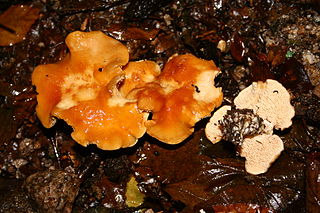
Hydnum rufescens, commonly known as the terracotta hedgehog, is an edible basidiomycete of the family Hydnaceae. It belongs to the small group of mushrooms often referred to as the tooth fungi, which produce fruit bodies whose cap undersurfaces are covered by hymenophores resembling spines or teeth, and not pores or gills.

Hydnellum peckii is a fungus in the genus Hydnellum of the family Bankeraceae. It is a hydnoid species, producing spores on the surface of vertical spines or tooth-like projections that hang from the undersurface of the fruit bodies. It is found in North America, Europe, and was recently discovered in Iran (2008) and Korea (2010). Hydnellum peckii is a mycorrhizal species, and forms mutually beneficial relationships with a variety of coniferous trees, growing on the ground singly, scattered, or in fused masses.

Hydnellum caeruleum, commonly known as the blue-gray hydnellum, blue-green hydnellum, blue spine, blue tooth, or bluish tooth, is an inedible fungus found in North America, Europe, and temperate areas of Asia.

The Hydnaceae are a family of fungi in the order Cantharellales. Originally the family encompassed all species of fungi that produced basidiocarps having a hymenium consisting of slender, downward-hanging tapering extensions referred to as "spines" or "teeth", whether they were related or not. This artificial but often useful grouping is now more generally called the hydnoid or tooth fungi. In the strict, modern sense, the Hydnaceae are limited to the genus Hydnum and related genera, with basidiocarps having a toothed or poroid hymenium. Species in the family are ectomycorrhizal, forming a mutually beneficial relationship with the roots of trees and other plants. Hydnum repandum is an edible species, commercially collected in some countries and often marketed under the French name pied de mouton.
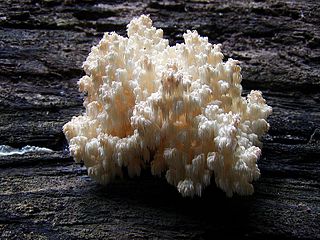
Hericium is a genus of edible mushrooms in the family Hericiaceae. Species in this genus are white and fleshy and grow on dead or dying wood; fruiting bodies resemble a mass of fragile icicle-like spines that are suspended from either a branched supporting framework or from a tough, unbranched cushion of tissue. This distinctive structure has earned Hericium species a variety of common names—monkey's head, lion's mane, and bear's head are examples. Taxonomically, this genus was previously placed within the order Aphyllophorales, but recent molecular studies now place it in the Russulales.

The hydnoid fungi are a group of fungi in the Basidiomycota with basidiocarps producing spores on pendant, tooth-like or spine-like projections. They are colloquially called tooth fungi. Originally such fungi were referred to the genus Hydnum, but it is now known that not all hydnoid species are closely related.

Sistotrema is a genus of fungi in the family Hydnaceae. The genus contains at least 55 species and has a worldwide distribution. The type species is Sistotrema confluens Pers. (1794).

Hydnum umbilicatum, commonly known as the depressed hedgehog, is a species of tooth fungus in the family Hydnaceae. It was scientifically described in 1902 from New York by American mycologist Charles Horton Peck. It is found in eastern North America. It is edible and good.

Hydnum ellipsosporum is a species of fungus in the family Hydnaceae that was described from Germany in 2004. It differs from H. repandum by the shape and length of its spores, which are ellipsoid and measure 9–11 by 6–7.5 µm. Compared to H. repandum, it has smaller fruit bodies, with cap diameters ranging from 3 to 5 cm wide.

Hydnum albomagnum, commonly known as the giant hedgehog, is a species of fungus in the family Hydnaceae native to North and Central America.
Hydnum magnorufescens is a species of fungus in the family Hydnaceae native to the southern Europe, Sichuan Province in China and Russia.
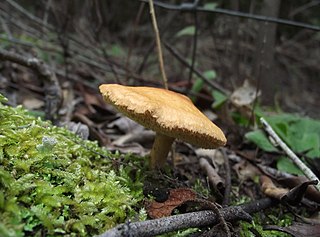
Hydnum ovoideisporum is a species of fungus in the family Hydnaceae native to the southern Europe.
Hydnum vesterholtii is a species of fungus in the family Hydnaceae native to the southern and Central Europe and southwestern China.

Hydnum crocidens is a species of fungus in the family Hydnaceae native to Australia. It was described in 1890 by Mordecai Cubitt Cooke from material collected around Port Phillip Bay. Genetic analysis shows it to be closely related to a lineage containing H. rufescens and its close relatives.
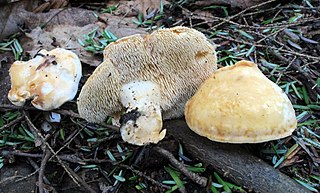
Hydnum albidum, commonly known as the white hedgehog, is an edible species of fungus in the family Hydnaceae native to North America.

Hydnum oregonense is a species of tooth fungus in the family Hydnaceae. It was scientifically described in 2018 by Norvell, Liimat. & Niskanen.
Hericium fimbrillatum is a species of fungus in the family Hericiaceae native to East Asia, given its current name by Ryo Sugawara, Nitaro Maekawa, Kozue Sotome, Akira Nakagiri, Naoki Endo in 2022, who transferred it from the Hydnum genus.





































